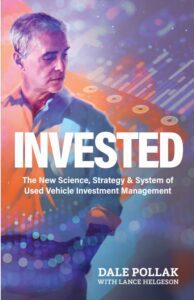One of the most persistent topics of conversation with dealers of late has been the difficulty they experience working with customers who want to trade or sell  a vehicle that’s saddled with an out-size level of negative equity.
a vehicle that’s saddled with an out-size level of negative equity.
I’ll get to some pointers for dealers to best help customers find a way out of their current vehicle and situation in a moment. First, though, let’s take a quick look at Cox Automotive data that underscores why negative equity has become such a pain point for current vehicle owners:
- Customers who purchased a used vehicle in the first quarter of 2022 had a negative equity of $4,232 after 12 months. That figure compares to the pre-COVID average of roughly $2,900 in negative equity on used loans after the first year.
- Customers who purchased a used vehicle between the fourth quarter of 2021 and third quarter of 2022 now have an average negative equity that runs two to three times higher than the long-term average for the industry of $1,550 for loans after two years.
- Meanwhile, the share of new vehicle loans that include negative equity has risen to 39 percent from its long-term average of 33 percent. The current share of 39 percent has diminished by roughly 3 percent since the beginning of last year, likely due to lenders tightening their requirements. There’s a similar story for used vehicle loans—the current share of used loans with negative equity is 58 percent, which is below the long-term average of 63 percent. However, the share has grown by 2 percent since the beginning of last year.
The dollar averages here pale in comparison to some of the anecdotes that dealers share—the woman whose husband purchased a new $65,000 Mercedes for $80,000 two years ago, and had to pay off $17,000 in negative equity to sell the car when her husband passed away; the customer who paid $9,000 to resolve negative equity for a three-year-old Audi after the selling dealer refused to make an offer on the vehicle; the pick-up owner who couldn’t get out of their vehicle due to more than $20,000 in negative equity.
Best I can tell, the rise in negative equity owes to the combination of sky-high values for new and used vehicles between 2021 and 2023 that have since depreciated rapidly, the practice on the part of some dealers to sell new vehicles for significantly more than MSRP and lenders’ loan requirements, which allowed customers to purchase vehicles at elevated prices and roll over pre-existing negative equity into their new/used vehicle purchase.
But I would add that the negative equity for some dealers isn’t as dramatic, a difference that seemingly owes to their decision to not sell new vehicles over MSRP at a time when they could.
“We’re seeing negative equity, for sure,” says Adam Arens, dealer principal for a four-store group that includes Acura, Subaru and Nissan stores in Maine, Massachusetts and New Hampshire. “But as a brand and group, there’s probably less impact of the negative equity that we’re seeing across the industry.”
Arens is among dealers who decided not to sell new vehicles above MSRP or sell a new vehicle outside their primary market area unless it was for a previous customer. “I don’t know if it was the right thing to do, but it was the right thing for us,” Arens say. “The net result is we continue to do business with those customers. Our new car volume is somewhat dictated by availability and our used car volume continues to go up and set records. And our parts and service volume continue to set records.”
He adds: “We also had no employee turnover and continue to have no turnover. With downturn of gross, turnover’s pretty high in this business and we’ve been able to avoid that.”
During the NADA convention in 2022, I noted the decision Arens and other dealers made to not sell new vehicles above MSRP. At the time, they viewed the practice as a near-term opportunity that might seed longer-term harm for loyalty and satisfaction among their customers and employees.
Today, it seems like the concerns Arens and others shared in 2022 have arrived for the broader industry: Dealers are seeing customers who are often surprised, and less than happy, to learn how negative equity from a vehicle purchase decision a couple years ago means they can’t get out of their current car without paying a significant price.
I asked Arens and others for pointers on how to address the situation:
Show empathy. It’s important to take the time to hear a customer’s situation and story. After all, they came to you for help, often after they may have tried to sell the vehicle on their own. It doesn’t strike me as good business to refuse to at least make an offer on a customer’s vehicle, especially if you’re the one who sold the vehicle to them.
Educate but don’t point fingers. “We let them know we can maximize the value of the vehicle and take care of the other part of their problem,” Arens says. “However, there is a math equation that has to be done where they take responsibility. We outline their options. We also can track the trajectory of that car and let them know if it’s going in a positive or negative direction. The reality is almost everything is going negative, so waiting doesn’t solve the issue. In the end, you can’t point fingers. It doesn’t help.”
Arens uses vAuto data to show customers a 12-month valuation trendline for a vehicle in three-month segments. For almost every vehicle, the trendline shows vehicle values have and continue to head south. “Then, you can discuss how the ‘situation’ will not correct itself and offer to go over the options today,” he says. “Education has proven very good for relationship building.”
Give them your best offer on their current vehicle. vAuto Lead Performance Manager Dee Harris says it’s important for dealers working these deals to keep the focus on the customer’s current car and its value. Then, “only give them your highest number,” Harris advises. “Later, when their negative equity situation changes and they’re able to buy, what will they remember? Your trade allowance and how you treated them.”
The post An Empathy-based Approach for Customers with Negative Equity appeared first on Dale Pollak.





